Push Up Mastery
This program has been designed to help those of all skill levels; from the individual that cannot attain a single push up, to those looking to break the 100 mark. That being said, this program is not a quick fix. There are a few key principles that must be followed diligently in order to achieve success.
#1 Technique Mastery
Spend as much time as necessary perfecting your push up technique. The number one reason for failure on any push up test is simply due to technique. This should never be the case. Unlike the testing protocol, for this program always lower yourself until the chest touches the ground. This will train you to ALWAYS get low enough.
#2 Consistency
This program has been designed to be undertaken 3 days per week for as long as is needed until your goal is achieved. Do not make the common mistake of beginning this program one or two weeks before testing. Start now and stay consistent.
#3 Progression
Every single time you perform the program, the goal should be to improve, in some way, compared to last time. It doesn't have to be much but it needs to be something. Progression can be achieved through switching to a more difficult exercise; performing 1 or more repetitions; or holding that plank for 5 more seconds.
That being said below is the RMC Push Up Program. Complete all sets and reps for section 1, followed by section 2 and finally section 3.
| Section | Exercise | Repetitions |
|---|---|---|
| 1 | Push Up: Strength Progression | 4 x 10-15 |
| 2 | Push Up: Endurance Progression | 2 x AMAP (as many as possible) |
| 3 | Core Stability Progression | 3 x Variable (Varies depending on the exercise ) |
The way it has been designed is to address each component of fitness that comes into play during a push up. The first method of improving push up numbers is by increasing upper body strength. This is accomplished through a relatively low number of repetitions. The second method is increasing upper body muscular endurance. This is achieved by performing maximum repetitions using an easier exercise progression. Finally, core stability is addressed by the inclusion of plank variations.
To follow this program, begin with the simplest progression of each exercise, in each section. Once the full number of sets and repetitions is achieved (indicated in each exercise description), move onto the next progression. Each push up should be done with a smooth and steady rhythm.
If you have any questions or require assistance, please contact your PE Squadron Representative.
Strength progression
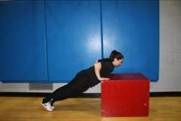 Hands elevated push ups
Hands elevated push ups
Place hands on an elevated surface (such as a counter, bench or any other raised object) and perform regular push ups. When you achieve 4 sets of 15 repetitions at that height, increase the difficulty of the exercise by lowering the height of the object.
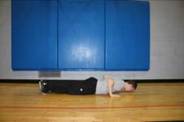 Push ups
Push ups
Perform a regular push up as demonstrated in the Push Up Protocol (see pages 1 & 2). Once 4 sets of 15 repetitions has been achieved, move onto the next progression.
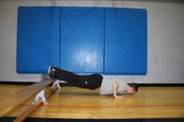 Feet elevated push ups or weighted push ups
Feet elevated push ups or weighted push ups
If no equipment is available perform push ups with feet elevated on a 12" surface. If equipment is available, either use a weighted vest or place weights on your back. Once 4 sets of 15 repetitions has been achieved using a relatively heavy load, move onto the next progression.
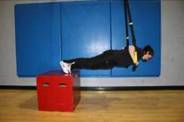 TRX or ring push ups
TRX or ring push ups
Using a TRX system or gymnastic rings, perform push ups starting with feet on the ground. Once 4 sets of 15 repetitions has been achieved, place feet onto an elevated surface. If this becomes easy, start adding weight in the form of a weighted vest.
Endurance Progression
 Push ups from knees
Push ups from knees
Perform regular push ups BUT with knees as the pivot point. Once you reach approximately 20-40 repetitions, move to the next progression.
If you cannot achieve 20-40 repetitions on your knees, begin on your knees BUT with hands elevated.
 Hands elevated push ups
Hands elevated push ups
Perform Hands Elevated Push Ups (technique described above) for as many repetitions as possible. At any given height, once between 20-40 push ups are reached, decrease the height until you are performing regular push ups.
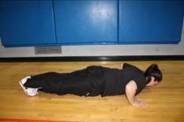 Push ups
Push ups
Perform regular Push Ups for as many repetitions as possible. Once between 30-50 push ups are reached, move to the next progression.
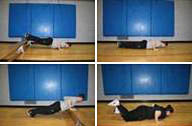 Push up complex
Push up complex
Perform as many Feet Elevated Push Ups as possible. Immediately switch to regular Push Ups for as many repetitions as possible. Immediately switch to Hands Elevated Push Ups and perform as many repetitions as possible. Immediately switch to Push Ups from Knees. Once a high number of repetitions has been achieved, you may add some extra weight through weighted vests or plates.
Core Progression
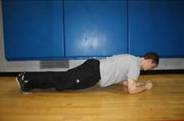 Plank
Plank
While resting on the elbows, maintain a complete erect position. From the side, you should be able to draw a straight line from heels to the top of the head. Concentrate on flexing all muscles of the body (with special emphasis on glutes and abs). Once 3 sets of 2 minutes can be easily accomplished, move onto the next progression.
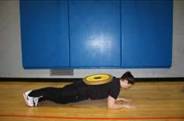 Weighted plank
Weighted plank
Same as above but add extra resistance by using either a weighted vest, OR weights on the back.
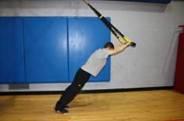 TRX rollouts
TRX rollouts
Set up the TRX in the same manner as the initial position of a TRX push up. Let hands drift forward and at furthest point possible, reverse the motion.
Push up protocol
Start position
 In the start position the individual lies flat on their stomach with their legs and feet together. Hands pointing forward are positioned underneath the shoulders. To establish an acceptable hand position the evaluator may stand directly over the individual being tested. If the evaluator can see the entire hand(s) (including fingers and thumb), then the position of the hands is too wide. Conversely, if the hands are under the chest and the evaluator cannot see any portion of the hand(s) then the position is too narrow. Elbows are comfortably back along the sides;
In the start position the individual lies flat on their stomach with their legs and feet together. Hands pointing forward are positioned underneath the shoulders. To establish an acceptable hand position the evaluator may stand directly over the individual being tested. If the evaluator can see the entire hand(s) (including fingers and thumb), then the position of the hands is too wide. Conversely, if the hands are under the chest and the evaluator cannot see any portion of the hand(s) then the position is too narrow. Elbows are comfortably back along the sides;
Movement/extension phase
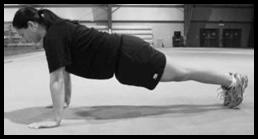 Using the toes as the pivot point, the individual pushes up from the floor/mat (if using a mat, use only a very thin or a very firm mat so as not to affect the integrity of the push-up) by straightening the arms to full extension. During this extension movement the elbows may flare out to the side as long as the hands remain in position pointing forward (it is not required that the individual maintains his or her elbows close to the sides during the movement phase, thus performing more of a triceps push-up). The body must be kept in a straight line including the head. The head should not normally be cocked to look forward-such action is contraindicated. The individual descends to the down position;
Using the toes as the pivot point, the individual pushes up from the floor/mat (if using a mat, use only a very thin or a very firm mat so as not to affect the integrity of the push-up) by straightening the arms to full extension. During this extension movement the elbows may flare out to the side as long as the hands remain in position pointing forward (it is not required that the individual maintains his or her elbows close to the sides during the movement phase, thus performing more of a triceps push-up). The body must be kept in a straight line including the head. The head should not normally be cocked to look forward-such action is contraindicated. The individual descends to the down position;
Down Position
The down position differs from the start position in that the individual does not return to lying on their stomach. During the execution of their push-ups the individual must keep their body suspended off the floor/mat throughout the evaluation. The proper down position has the back of the upper arms (triceps area) parallel to the floor/mat. The chin, chest area, stomach, thighs, or knees should not touch the floor/mat in the down position. Incidental contact of any body part should not be used as a reason to terminate the test, or not count push-ups, unless the individual through such contact gains a clear advantage. Once the individual has attained the down phase they continue with the next push-up (extension phase);
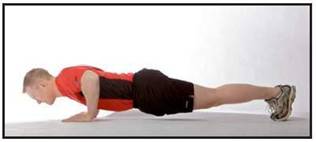
Counting
Push-ups are to be performed continuously and without a time limit. Push-ups that do not conform to the described protocol will not be counted. The test shall be discontinued as soon as the individual is seen to strain forcibly to complete a push-up or is unable to maintain proper push-up technique. In many cases, lack of compliance with protocol (e.g., arching back on a push-up, not going down far enough, moving hands farther apart) can be corrected verbally and simply results in push-ups that do not count. Such situations should not result in termination of the test unless it is evident that advantage is being gained. Count the initial movement up as one and then count each subsequent repetition to full extension.
Discontinuation of the test
The evaluator shall discontinue the test:
- If the individual voluntarily terminates the test.
- If the individual is seen to strain forcibly to complete a push-up.
- If the individual demonstrates alarming physiological signs and symptoms that could impede on his safety or health.